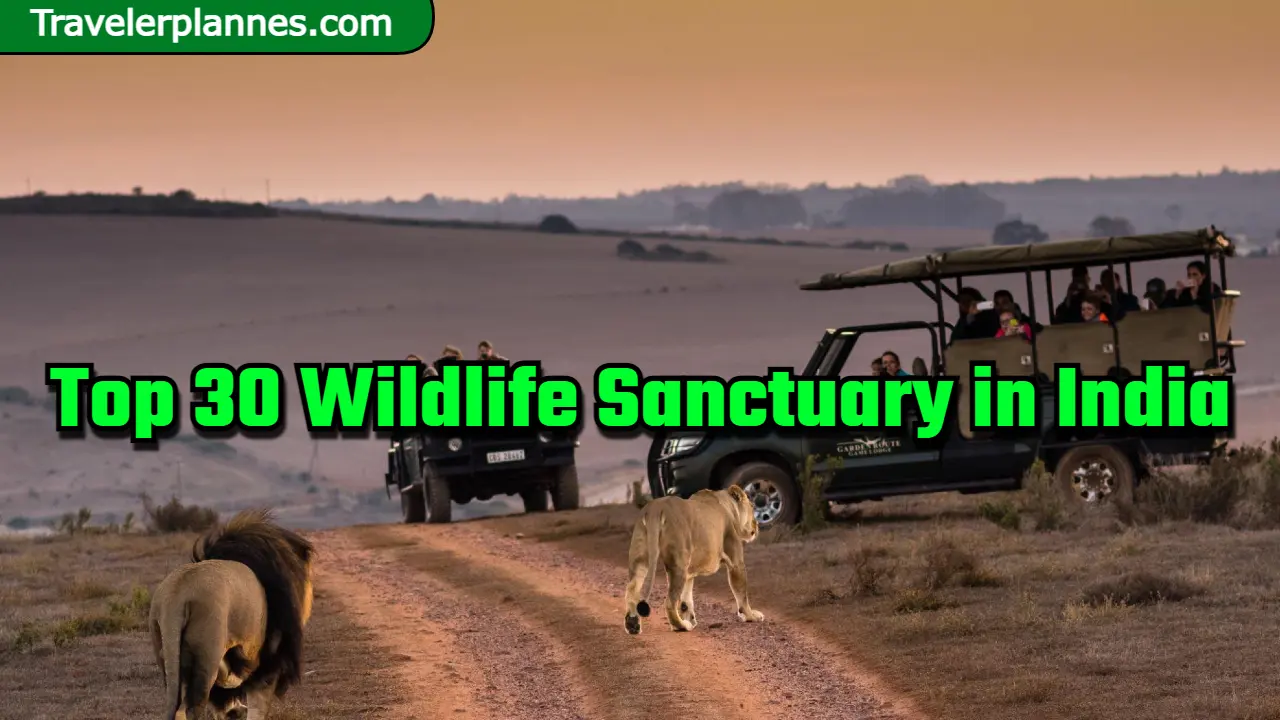India, with its rich and various environment, is home to a portion of the world’s most enrapturing natural life safe-havens. From the snow-covered Himalayas in the north to the perfect woodlands of the Western Ghats in the south, India brags a staggering cluster greenery. These safeguarded regions save the country’s biodiversity as well as proposition an exceptional chance for untamed life devotees and protectionists to observe nature’s marvels very close. In this exhaustive aide, we’ll take you on a virtual visit through the best 30 natural life safe-havens in India, each with its own unmistakable appeal and captivating natural life.
- Jim Corbett National Park, Uttarakhand
- Sundarbans National Park, West Bengal
- Kaziranga National Park, Assam
- Ranthambore National Park, Rajasthan
- Periyar Wildlife Sanctuary, Kerala
- Kanha National Park, Madhya Pradesh
- Bandipur National Park, Karnataka
- Pench National Park, Madhya Pradesh
- Gir Forest National Park, Gujarat
- Nagarhole National Park, Karnataka
- Sariska Tiger Reserve, Rajasthan
- Bhadra Wildlife Sanctuary, Karnataka
- Dachigam National Park, Jammu and Kashmir
- Mudumalai National Park, Tamil Nadu
- Tadoba Andhari Tiger Reserve, Maharashtra
- Silent Valley National Park, Kerala
- Valmiki National Park, Bihar
- Simlipal National Park, Odisha
- Indravati National Park, Chhattisgarh
- Nanda Devi National Park, Uttarakhand
- Hemis National Park, Ladakh
- Great Himalayan National Park, Himachal Pradesh
- Palamau Tiger Reserve, Jharkhand
- Nameri National Park, Assam
- Satpura Tiger Reserve, Madhya Pradesh
- Sathyamangalam Wildlife Sanctuary, Tamil Nadu
- Balphakram National Park, Meghalaya
- Panna Tiger Reserve, Madhya Pradesh
- Pilibhit Tiger Reserve, Uttar Pradesh
- Bannerghatta Biological Park, Karnataka
Contents
- 1 1. Jim Corbett National Park, Uttarakhand
- 2 2. Sundarbans National Park, West Bengal
- 3 3. Kaziranga National Park, Assam
- 4 4. Ranthambore National Park, Rajasthan
- 5 5. Periyar Wildlife Sanctuary, Kerala
- 6 6. Kanha National Park, Madhya Pradesh
- 7 7. Bandipur National Park, Karnataka
- 8 8. Pench National Park, Madhya Pradesh
- 9 9. Gir Forest National Park, Gujarat
- 10 10. Nagarhole National Park, Karnataka
- 11 11. Sariska Tiger Reserve, Rajasthan
- 12 12. Bhadra Wildlife Sanctuary, Karnataka
- 13 13. Dachigam National Park, Jammu and Kashmir
- 14 14. Mudumalai National Park, Tamil Nadu
- 15 15. Tadoba Andhari Tiger Reserve, Maharashtra
- 16 16. Silent Valley National Park, Kerala
- 17 17. Valmiki National Park, Bihar
- 18 18. Simlipal National Park, Odisha
- 19 19. Indravati National Park, Chhattisgarh
- 20 20. Nanda Devi National Park, Uttarakhand
- 21 21. Hemis National Park, Ladakh
- 22 22. Great Himalayan National Park, Himachal Pradesh
- 23 23. Palamau Tiger Reserve, Jharkhand
- 24 24. Nameri National Park, Assam
- 25 25. Satpura Tiger Reserve, Madhya Pradesh
- 26 26. Sathyamangalam Wildlife Sanctuary, Tamil Nadu
- 27 27. Balphakram National Park, Meghalaya
- 28 28. Panna Tiger Reserve, Madhya Pradesh
- 29 29. Pilibhit Tiger Reserve, Uttar Pradesh
- 30 30. Bannerghatta Biological Park, Karnataka
- 31 Conclusion
1. Jim Corbett National Park, Uttarakhand
The beautiful state of Uttarakhand is home to India’s first and oldest national park, Jim Corbett National Park. It’s about 520 square kilometers in size, and it’s famous for housing a large number of tigers, allowing visitors to see these magnificent animals in their native environment. The park is home to about 600 different species of birds in addition to the tigers, leopards, and elephants. The park’s beauty, which consists of forested hills, grassy plains, and the winding Ramganga River, is ideal for nature lovers. Exciting vehicle safaris, elephant rides, and birdwatching trips allow guests to explore the area and take in its natural wonders.
2. Sundarbans National Park, West Bengal
As the biggest mangrove forest in the world, Sundarbans National Park is a natural wonder and a UNESCO World Heritage Site. It is well-known as the home of the elusive Royal Bengal Tiger and is situated in the delta region of West Bengal. Species from all over the world have adapted to this one-of-a-kind habitat created by the mixing of freshwater from the Ganges and saltwater from the Bay of Bengal. Numerous bird species and saltwater crocodiles both flourish there. Taking a boat excursion through the mangroves of the Sundarbans is an exciting part of any trip to the region. Countless avian species make their homes here, making it a paradise for birdwatchers.
3. Kaziranga National Park, Assam
Kaziranga National Park, nestled in the northeastern state of Assam, is a conservation success story. The park’s most iconic resident is the Indian one-horned rhinoceros, whose population has rebounded significantly due to dedicated efforts. In addition to rhinos, Kaziranga is home to a high density of Bengal tigers and a wide variety of bird species. The park’s landscape, with tall elephant grass, dense forests, and wetlands, makes it a unique and thriving habitat. Visitors can explore Kaziranga on exciting jeep safaris, elephant-back rides, and guided birdwatching tours, offering unforgettable encounters with the diverse wildlife in this pristine environment.
4. Ranthambore National Park, Rajasthan
Ranthambore National Park, situated in the royal state of Rajasthan, is a wildlife gem known for its historical and natural grandeur. The park’s highlight is the imposing Ranthambore Fort, which provides a historic backdrop to the wilderness. Ranthambore is famous for its Bengal tigers, which can often be spotted during safaris. Apart from tigers, leopards, sloth bears, and a variety of bird species call this park home. Jeep safaris offer an opportunity to explore the park’s rugged terrain and diverse ecosystems while keeping an eye out for elusive wildlife. The park’s unique blend of history and nature makes it a must-visit destination for wildlife enthusiasts and history buffs alike.
5. Periyar Wildlife Sanctuary, Kerala
Periyar Wildlife Sanctuary, located in the lush Western Ghats of Kerala, is often referred to as the “Gem of the Western Ghats.” The sanctuary is renowned for its rich biodiversity and stunning landscapes. It’s home to a healthy population of Bengal tigers and elephants, making it a prime destination for wildlife enthusiasts. Periyar also boasts aromatic spice plantations, adding to the sensory experience. One of the unique activities here is the boat safari on Periyar Lake, which allows visitors to witness wildlife congregating at the water’s edge. It’s an excellent opportunity for birdwatching and catching glimpses of various wildlife species. Periyar Wildlife Sanctuary offers a serene and immersive wildlife experience in the heart of Kerala’s natural beauty.
6. Kanha National Park, Madhya Pradesh
Kanha National Park, located in the central Indian state of Madhya Pradesh, is often referred to as the inspiration behind Rudyard Kipling’s “The Jungle Book.” This iconic park is known for its lush sal forests, meadows, and abundant wildlife. It’s particularly famous for the preservation of the rare Barasingha, or swamp deer. Bengal tigers roam freely in these forests, making tiger sightings a common occurrence. Visitors can enjoy thrilling jeep safaris through the park’s diverse landscapes, providing ample opportunities for wildlife photography. Kanha has also made significant strides in wildlife conservation, making it a model for sustainable ecotourism and preserving India’s natural heritage.
7. Bandipur National Park, Karnataka
Bandipur National Park, part of the Nilgiri Biosphere Reserve in Karnataka, is a haven for endangered wildlife. The park’s diverse ecosystem supports a variety of species, including Bengal tigers, Indian elephants, and gaurs. Bandipur’s commitment to sustainable tourism has led to a harmonious coexistence between humans and wildlife. Visitors can embark on jeep safaris through the park’s lush forests and grasslands, offering a chance to spot these majestic creatures in their natural habitat. The park is also a paradise for birdwatchers, with numerous avian species gracing the skies. Bandipur’s dedication to conservation and responsible tourism makes it a must-visit destination for nature enthusiasts.
8. Pench National Park, Madhya Pradesh
Pench National Park, located in Madhya Pradesh, is renowned for its scenic beauty and its association with Rudyard Kipling’s classic, “The Jungle Book.” The park’s landscape is characterized by dense forests, meandering rivers, and rolling hills. Pench is home to a thriving population of Bengal tigers, leopards, and various other wildlife species. Visitors can enjoy exciting jeep safaris and elephant rides, which offer a chance to witness the park’s vibrant biodiversity. Pench is also committed to community-based conservation efforts, involving local communities in wildlife protection and ecotourism initiatives. This harmonious approach to conservation has resulted in the park being a prime example of how responsible tourism can contribute to preserving India’s natural treasures.
9. Gir Forest National Park, Gujarat
Gir Forest National Park in Gujarat holds a unique distinction as the last remaining refuge of the Asiatic lion. The park’s rugged terrain and dry deciduous forests provide a suitable habitat for these majestic big cats. Apart from lions, Gir is home to a variety of wildlife species, including leopards, hyenas, and sambar deer. Visitors can embark on lion safaris, gaining a rare opportunity to witness these incredible creatures in their natural habitat. Gir also offers insights into the region’s rich flora and fauna, making it an enriching experience for nature enthusiasts. The park’s conservation efforts have been crucial in protecting the endangered Asiatic lion, making Gir an essential destination for wildlife conservation enthusiasts.
10. Nagarhole National Park, Karnataka
Nagarhole National Park, part of the Nilgiri Biosphere Reserve, is nestled in the scenic Coorg region of Karnataka. The park’s name, Nagarhole, translates to “Snake River,” a reference to the winding Kabini River that flows through it. Nagarhole is known for its lush greenery and is teeming with wildlife, including tigers, leopards, elephants, and a diverse range of bird species. Visitors can enjoy boat safaris on the Kabini River, offering a unique perspective of the park’s wildlife congregating along the riverbanks. The park also offers thrilling jeep safaris and treks through its pristine forests, providing an immersive experience for nature enthusiasts. Nagarhole’s commitment to wildlife conservation and responsible tourism ensures that it remains a natural treasure for generations to come.
11. Sariska Tiger Reserve, Rajasthan
Sariska Tiger Reserve, located in the royal state of Rajasthan, is known for its dramatic landscapes and the successful reintroduction of Bengal tigers. The park is home to diverse wildlife, including leopards, sambar deer, and a variety of bird species. Sariska’s unique feature is its proximity to historic ruins, such as the Sariska Palace and the Neelkanth Temples, adding a touch of cultural heritage to the wilderness. Eco-sensitive tourism is encouraged here, allowing visitors to explore the park responsibly while appreciating its natural beauty. Sariska’s conservation efforts, including the reintroduction of tigers, have been instrumental in reviving the park’s ecological balance and making it a destination for wildlife enthusiasts and history buffs alike.
12. Bhadra Wildlife Sanctuary, Karnataka
Bhadra Wildlife Sanctuary, located in the Western Ghats of Karnataka, is a hidden gem that offers a pristine natural experience. The sanctuary is known for its dense forests, rugged terrain, and diverse wildlife. Tiger sightings are relatively common here, and the park is also a birdwatcher’s paradise, with over 250 avian species. Visitors can enjoy thrilling jeep safaris, nature walks, and birdwatching excursions, immersing themselves in the park’s rich biodiversity. Bhadra Wildlife Sanctuary actively engages in conservation and community awareness programs, ensuring that this Western Ghats gem remains a thriving habitat for wildlife and a sanctuary for nature enthusiasts.

- Pune Travel Guide: Unraveling the City’s Wonders
- Top 25 Tourist Places in India – You Must Visit These Places
- Explore the Top 10 Varkala Beach Resorts for a Relaxing Getaway
13. Dachigam National Park, Jammu and Kashmir
Dachigam National Park, nestled in the picturesque state of Jammu and Kashmir, is known for its high-altitude beauty and the preservation of the endangered Hangul deer. The park’s landscape is characterized by alpine meadows, dense forests, and pristine streams. Apart from Hangul deer, Dachigam is home to the elusive Kashmiri stag and various species of Himalayan birds. Visitors can explore the park’s breathtaking scenery while keeping an eye out for these unique wildlife species. Dachigam also serves as a center for research and conservation, actively contributing to the protection of its endangered inhabitants. For those seeking an offbeat wildlife experience amidst the Himalayas, Dachigam National Park is a must-visit destination.
14. Mudumalai National Park, Tamil Nadu
Mudumalai National Park, located in the Nilgiri Hills of Tamil Nadu, is a treasure trove of biodiversity. The park’s diverse landscapes, including dense forests, grassy meadows, and hilly terrain, create a thriving habitat for numerous wildlife species. Tigers, leopards, elephants, and sloth bears are among the park’s residents. Mudumalai also offers the unique experience of visiting elephant camps, where visitors can interact with and learn about these magnificent creatures. Thrilling jeep safaris and nature walks allow you to immerse yourself in the park’s natural beauty while observing its wildlife. Mudumalai’s focus on sustainable tourism and conservation makes it a remarkable destination for wildlife enthusiasts and nature lovers.
15. Tadoba Andhari Tiger Reserve, Maharashtra
Tadoba Andhari Tiger Reserve, located in Maharashtra, is often referred to as the “Jewel of Vidarbha.” The park is known for its thriving population of Bengal tigers and offers excellent opportunities for tiger sightings. In addition to tigers, Tadoba is home to leopards, sloth bears, and a rich variety of bird species. The reserve provides a unique experience with night safaris, allowing visitors to witness the park’s nocturnal creatures in action. The scenic beauty of the Denwa River adds to the charm of this tiger haven. Tadoba’s conservation efforts, including habitat restoration and anti-poaching measures, have contributed to its reputation as a sanctuary for these magnificent cats and a must-visit destination for wildlife enthusiasts.
16. Silent Valley National Park, Kerala
Silent Valley National Park, located in the Western Ghats of Kerala, is a haven of evergreen wilderness. The park’s name originates from the perceived absence of the sounds of cicadas, as the lush rainforest canopy absorbs much of the noise. Silent Valley is home to the endangered lion-tailed macaques, as well as tigers, leopards, and a rich diversity of bird species. Trekking through the rainforest trails is a unique experience, offering an opportunity to witness the park’s flora and fauna up close. Silent Valley’s commitment to conservation and preserving biodiversity makes it an enchanting destination for nature enthusiasts and a testament to the importance of protecting India’s rainforests.
17. Valmiki National Park, Bihar
Valmiki National Park, located in Bihar, is a lesser-known gem in India’s wildlife landscape. The park is home to a variety of wildlife, including Bengal tigers, sloth bears, and sambar deer. The tranquil wilderness of Valmiki offers a serene atmosphere for visitors to connect with nature. Jeep safaris and nature walks provide opportunities to explore the park’s diverse ecosystems and observe its inhabitants. Valmiki’s commitment to responsible tourism ensures that visitors can enjoy the park’s natural beauty while minimizing their ecological footprint. The park’s remoteness adds to its charm, providing an offbeat wildlife experience for those seeking a peaceful retreat amidst nature.
18. Simlipal National Park, Odisha
Simlipal National Park, located in Odisha, is a hidden treasure boasting lush landscapes, thriving wildlife, and stunning waterfalls. The park is home to Bengal tigers, leopards, and a diverse range of bird species. Visitors can explore the park’s unique ecosystem while enjoying jeep safaris and trekking to waterfalls like Joranda and Barehipani. Simlipal actively engages in ecotourism initiatives, providing a responsible and enriching experience for nature enthusiasts. The park’s scenic beauty, combined with its commitment to conservation, makes it a destination worth discovering for those seeking an offbeat wildlife adventure.
19. Indravati National Park, Chhattisgarh
Indravati National Park, situated in Chhattisgarh, is a pristine wilderness that boasts a variety of wildlife, including Bengal tigers and wild buffaloes. The park’s remote location and dense forests make it a haven for nature enthusiasts seeking solitude and untamed landscapes. Jeep safaris and trekking expeditions offer opportunities to explore the park’s diverse habitats while appreciating its rich biodiversity. Indravati faces unique conservation challenges due to its remote location, making it an intriguing destination for those interested in the complexities of wildlife preservation. The park’s untouched beauty and commitment to safeguarding its inhabitants make it an offbeat yet rewarding wildlife sanctuary to explore.
20. Nanda Devi National Park, Uttarakhand
Nanda Devi National Park, nestled in the Himalayan state of Uttarakhand, is a testament to the breathtaking beauty of the Western Himalayas. The park is named after the imposing Nanda Devi Peak, India’s second-highest mountain. It’s known for its pristine landscapes and unique wildlife, including snow leopards and blue sheep. The park offers incredible trekking and mountaineering opportunities, with trails that take you through lush meadows and alpine forests. Nanda Devi’s remote location and limited access ensure that it remains an unspoiled paradise for those seeking high-altitude adventure amidst snow-capped peaks. Conservation efforts in the park focus on preserving its fragile ecosystems and unique inhabitants, making it a must-visit destination for Himalayan enthusiasts and nature lovers.
21. Hemis National Park, Ladakh
Hemis National Park, situated in the rugged landscapes of Ladakh, is a high-altitude sanctuary known for its elusive snow leopards and Himalayan wolves. The park’s unique landscape, characterized by barren mountains and high plateaus, adds to its mystique. Visitors can embark on snow leopard safaris, offering a rare opportunity to spot these elusive cats in their natural habitat. Hemis also provides insights into the traditional culture of Ladakh, with its annual Hemis Festival celebrating the region’s rich heritage. Responsible tourism practices are emphasized here to ensure that the park’s fragile ecosystem is preserved for generations to come. Hemis National Park offers an extraordinary adventure in the stark beauty of the Himalayas and is a bucket-list destination for wildlife enthusiasts.
22. Great Himalayan National Park, Himachal Pradesh
Great Himalayan National Park, a UNESCO World Heritage Site, is located in the pristine landscapes of Himachal Pradesh. The park is celebrated for its rich biodiversity and protection of the Western Himalayan ecosystem. It’s home to a variety of wildlife, including the elusive snow leopard, Himalayan brown bear, and numerous bird species. Trekkers and nature enthusiasts can explore the park’s extensive network of trails, offering breathtaking vistas of the Himalayan peaks and lush valleys. Great Himalayan National Park actively engages in conservation initiatives, emphasizing the importance of preserving its unique ecosystems. The park’s commitment to sustainable tourism ensures that visitors can experience the grandeur of the Himalayas while contributing to its long-term protection.
23. Palamau Tiger Reserve, Jharkhand
Palamau Tiger Reserve, located in Jharkhand, is known as the “Tiger’s Domain” and is one of India’s lesser-known tiger reserves. The reserve is characterized by dry deciduous forests and a network of rivers and streams. Apart from tigers, Palamau is home to leopards, elephants, and a variety of bird species. Jeep safaris allow visitors to explore the reserve’s rugged terrain and observe its wildlife. The park’s proximity to historic ruins, including the Palamau Fort, adds a touch of cultural heritage to the wilderness. Community participation is a key element of Palamau’s conservation efforts, ensuring that local communities are active partners in wildlife protection. The reserve offers a unique wildlife experience for those seeking an offbeat destination in the heart of India.
24. Nameri National Park, Assam
Nameri National Park, located in Assam, is a pristine wilderness that offers a glimpse into the beauty of the Brahmaputra River. The park is home to the critically endangered white-winged wood duck, making it a significant destination for birdwatchers and wildlife enthusiasts. Visitors can enjoy river rafting on the Jia Bhoroli River, offering a unique perspective of the park’s lush landscapes and diverse wildlife. Nameri is also known for its efforts in wildlife conservation and eco-tourism initiatives, ensuring that visitors can experience the park’s natural wonders while contributing to its preservation. The park’s tranquil ambiance and commitment to protecting its unique inhabitants make it a rewarding destination for nature lovers.
25. Satpura Tiger Reserve, Madhya Pradesh
Satpura Tiger Reserve, located in Madhya Pradesh, is a hidden gem known for its stunning landscapes and thriving wildlife. The reserve is home to leopards, sloth bears, and a variety of bird species. The Denwa River flows through the reserve, providing a picturesque backdrop for safaris and boat trips. Visitors can enjoy canoeing on the river and jeep safaris through the reserve’s diverse ecosystems. Satpura’s commitment to sustainable ecotourism ensures that visitors can explore its natural beauty while minimizing their impact on the environment. The reserve’s unique blend of adventure and tranquility makes it a must-visit destination for those seeking an offbeat wildlife experience.
26. Sathyamangalam Wildlife Sanctuary, Tamil Nadu
Sathyamangalam Wildlife Sanctuary, spanning the borders of Tamil Nadu, Karnataka, and Kerala, is a vast and biodiverse landscape. The sanctuary is known for its significant tiger population and unique landscape that transitions from dry deciduous forests to lush evergreen forests. Visitors can embark on thrilling jeep safaris and forest treks to explore the sanctuary’s diverse habitats and wildlife. The sanctuary’s remote location and rugged terrain make it an exciting destination for nature enthusiasts seeking an offbeat adventure. Sathyamangalam’s conservation success stories underscore the importance of preserving this pristine wilderness for future generations.
27. Balphakram National Park, Meghalaya
Balphakram National Park, located in the northeastern state of Meghalaya, is a lesser-known sanctuary that offers a glimpse into the world of clouded leopards and unique plateau landscapes. The park’s rugged terrain and unique geological formations create a habitat for diverse wildlife species. Visitors can explore the park’s wilderness on nature walks and jeep safaris, offering opportunities to spot clouded leopards, wild buffalo, and other elusive creatures. Balphakram also provides insights into the tribal culture of the region, adding a cultural dimension to the wildlife experience. The park’s challenges and conservation efforts make it an intriguing destination for those interested in the complexities of wildlife preservation.
28. Panna Tiger Reserve, Madhya Pradesh
Panna Tiger Reserve, located in Madhya Pradesh, is known for its stunning landscapes and conservation efforts, including the successful reintroduction of vultures. The reserve is home to tigers, leopards, and a variety of wildlife species. Visitors can enjoy boat safaris on the Ken River, offering a unique perspective of the park’s beauty and wildlife. Jeep safaris and wildlife photography opportunities are also available for nature enthusiasts. Panna’s commitment to conservation, including vulture conservation and habitat restoration, has contributed to its reputation as a sanctuary for both wildlife and the environment. The park’s scenic beauty, combined with its dedication to preserving India’s natural treasures, makes it a must-visit destination for wildlife enthusiasts.
29. Pilibhit Tiger Reserve, Uttar Pradesh
Pilibhit Tiger Reserve, located in Uttar Pradesh, is part of the Terai-Duar landscape, known for its Bengal tigers and swamp deer. The reserve is characterized by dense forests, grasslands, and riverine habitats. Visitors can embark on wildlife safaris and birdwatching tours, offering opportunities to observe tigers, leopards, and a variety of bird species. Pilibhit’s conservation efforts and community-based initiatives emphasize the importance of preserving this unique ecosystem. The reserve’s proximity to the Indo-Nepal border adds a cross-border dimension to its wildlife preservation efforts. Pilibhit offers a serene and enriching wildlife experience for those seeking to explore the lesser-known gems of India’s wildlife landscape.
30. Bannerghatta Biological Park, Karnataka
Bannerghatta Biological Park, located near Bangalore, is a unique urban wildlife sanctuary that offers a diverse range of experiences. The park is home to a variety of wildlife, including tigers, lions, and elephants. Visitors can explore the park on safari tours, which provide an opportunity to witness these magnificent creatures up close. Bannerghatta also features a butterfly park, a zoo, and a rescue and rehabilitation center for wildlife. The park plays a crucial role in urban conservation education, raising awareness about India’s wildlife and the importance of its protection. Bannerghatta’s role in the urban ecosystem underscores the significance of wildlife conservation efforts in both rural and urban settings.
Conclusion
India’s top 30 wildlife sanctuaries offer a remarkable journey through diverse landscapes and ecosystems, each with its unique charm and wildlife. These protected areas not only showcase India’s rich biodiversity but also stand as beacons of conservation and sustainability. Whether you’re a wildlife enthusiast, a nature photographer, or simply a traveler seeking a deep connection with the natural world, these sanctuaries provide unforgettable experiences.
As we celebrate and protect these natural havens, it’s crucial to remember our role in preserving these ecosystems for future generations. By visiting these sanctuaries, appreciating their beauty, and supporting their conservation efforts, we ensure that India’s wildlife continues to thrive and inspire awe for years to come.









